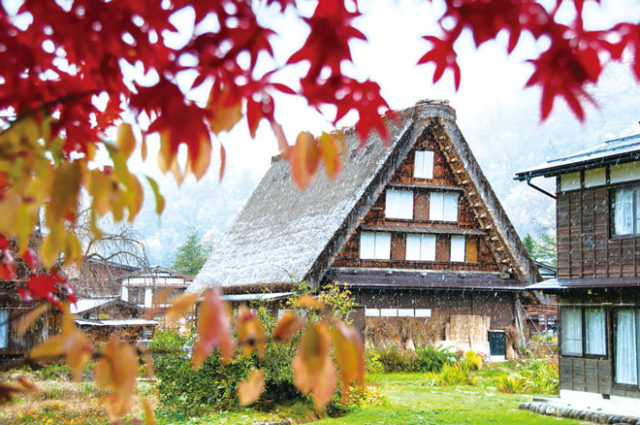
By John Foz
For The North American Post
This author joined the North American Post’s annual group tour to Japan. This is the first in a series of articles by tour members.
Our visits to the city of Takayama and historic village Shirakawa-go were fascinating adventures.
Takayama is a picturesque city in the Japan “Alps” inhabited by 60,000 residents, located 200 kilometers from Tokyo in Gifu Prefecture. It draws over a half a million to their spring planting and fall harvest festivals.
We rode the shinkansen (bullet train) and transferred in Nagoya to the diesel-electric Kuo line, which heads due north into rugged and dramatic mountain scenery dominated by lakes, hydro electric works, and stacks of logs and timber peeking out from the alpine forest.
At times it looked like the North Cascades in the Pacific Northwest. In fact, both the old growth wood and especially the woodworking craftsmen of this region were so renowned, they were used in the construction of many major temples and castles in Japan, including in Nara.
Takayama’s downtown is bisected by the Miyagawa River. In the town’s core is a compact district of old, perfectly preserved merchants’ mansions. Many of us wandered the three pedestrian streets in this area lined on both sides with original 200-year-old houses, many with the appearance of the historic, dark wooden edifices.
It was a holiday weekend when we made a day trip to Shirakawa-go, a 45- minute bus ride from Takayama.
Declared a UNESCO world heritage site in 1995, the village is home to several dozen well-preserved gassho-zukuri farmhouses, some of which are more than 250 years old.
The thatch-roofed farmhouses are amazing structures designed to withstand the harsh winter, while providing a place to work and live. Some of the more fragile, threatened buildings were relocated to an area as an open-air folk house museum.
Many of the farmhouses are now restaurants, shops, museums or minshuku, with overnight accommodations.
Bright flowers remained in bloom along the village pathways, and residents tended their gardens and did their chores, seemingly oblivious to the photo-taking visitors.
Many tourists took advantage of the mild, low 80’s temperature (a bad typhoon was underway on the coast) to wander the Ogimachi, the largest village and main attraction of Shirakawa-go.
Among the many scarecrows was a popular one that people took pictures next to, one gloved “hand” in the ubiquitous “peace” sign.
The golden rice in the residents’ fields seemed just days away from harvesting. In a remote part of town amid the quiet, forested upper reaches, I observed gas-powered hulling machinery in action in a work shed, just across from ancestral family grave sites and nearby, kimono line drying in the sun.
One outstanding structure in the main village we visited was the four-story Kanda house, continuously occupied for 200 years by the same family.
For 300 yen, visitors can explore all but the occupants’ living section and the 4th floor attic. Chonobari (curved) beams made up part of the roof structure, using strong trees whose bases grew naturally curved under the weight of snow.
Because of the threat of fire, the original designers installed a special window from the working mezzanine level to the ground level to check on the charcoal fire, which was constantly lit. The blackened ‘ember catcher’ and blackened timbers above the firepit attested to the many decades of activity.
I was amazed at the cross-members in the internal wall construction designed to withstand earthquakes and high winds, and the sturdiness of the entire structure overall.
The informative brochure explained how sericulture (silk production) occupied several floors, and that there was “under the floor” (underground or low key) production of chemicals for gunpowder for extra income.
Many of the original tools and machinery for silk production were on display, as were the tools for installing the thatch roof, which the entire community undertakes every 10 or 20 years.
While exploring an upper level we met a gentlemen who proudly showed off the job he completed replacing all the shoji screens in the building.
Another “first” on this trip was to observe Tokyo’s main Sumo tournament. We left a bit early to avoid the crush of people exiting the stadium, but our travel mates who stayed to the last bout witnessed the traditional tossing of the red cushions on the lower level when their fan favorite lost to his opponent.
Our tour coincided with the popular Toji Temple flea market. I spent a day exploring the market, which occupies the majority of the temple grounds. There was a jaw-dropping variety of artisan crafts, wares, food, snacks, and “garage sale” type offerings – I regretted not having more luggage space for purchases.
While this was my fourth group tour, it was truly a most memorable one.






